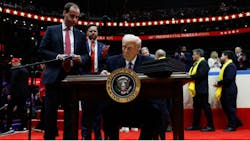On his first day in office, President Donald Trump signed an executive order to end EV mandates.
The order, titled “Unleashing American Energy,” fulfills a key campaign promise and ends a 2021 Biden administration policy that aimed to have EVs make up half of new car sales in the U.S. by 2030. As well as this, the executive order poses implications for California’s newly granted waiver that allows the state to enforce its pollution limits for new cars and passenger trucks.
You can read more about the history of these mandates/policies and their opposition on our website:
- White House sets plan to cut emissions, shift to electric for cars and trucks
- Biden's 2023 budget includes EVs, autonomous vehicles, and ADAS
- CARS Act passed by U.S. House of Representatives
- $623 million for EV charging network announced from Biden-Harris administration
- Opposition from SEMA members over California's banning of new gas-powered vehicles
- Supreme Court denies petition to review challenges to California's Clean Air Act provisions
What is the mandate?
While there is no direct federal mandate for electric vehicles, the Biden administration pushed automakers and buyers to shift from gas-powered vehicles to electric. Congress provided hundreds of billions of dollars to combat climate change at Biden’s urging.
In March 2024, the EPA announced national pollution standards for passenger cars, light duty trucks, and medium duty vehicles for model years 2027 through 2032 and beyond. As well as this, the EPA granted California a waiver to phase out new gas-powered cars, a move adopted by several other states.
What does the order entail?
On the White House website, details of the executive order can be found. The order seeks to “promote true consumer choice…by removing regulatory barriers to motor vehicle access.” As well as this, it promises the “[termination], where appropriate, [of] state emissions waivers that function to limit sales of gasoline-powered automobiles.”
Not only does the order aim to put an end to regulations and policies that prioritize EV production over gas-powered vehicles, but it also takes away financial incentives and grants previously given to those who took the electric route. The order states it will consider the elimination of subsidies and tax credits given to those who buy new EVs and has already halted the distribution of federal funds for EV chargers.
Potential impacts
Electric vehicles have remained a contentious topic in the industry ever since they first hit the roads. In our 2024 Aftermarket Profile, 16 percent of shops reported that they offered EV services, and only 35 percent of shops reported not working on EV or hybrid vehicles at all. While the numbers are still small, there's no denying the billions of dollars poured into the EV sector.
K. Venkatesh Prasad, senior vice president at the Center for Automotive Research, says there is no way the transition to EVs can stop now, not with the financial and labor investments from automakers. Despite the Trump administration's claims that the EV mandate puts strain on the automotive industry, Prasad and other industry professionals disagree.
"There is no job-killing associated with the transition to EVs,” said Prasad in an article with the Washington Post. “There are fewer jobs on assembly lines if you take a myopic view. But if you take a broader perspective and look at jobs required to create batteries and jobs required to make cells that go into batteries, there are more jobs there.”
Another auto analyst at Bank of America, John Murphy, holds a slightly different view from Prasad.
“If the transition slows down, there’s less job risk immediately. … For the moment, it will probably help jobs,” Murphy said. “But if 10 years in the future EVs are really taking off and we haven’t made the requisite investments, it could really hurt jobs in the U.S.”
For some, the mandates simply don't give the industry enough time to adjust to EVs as the dominant kind of vehicle. PTEN Technical Editor Scott Brown admits he was "no fan of the mandates since they simply didn't make logical sense for everyone in every geographical area and for every use case."
"I believe that it's too early to make a call on what the overall impact will be, but one thing is for sure," Brown went on. "EVs are cheaper to operate over a 100,000-mile period. At $5.00/gallon gas here in California, one will spend [around] $16.5k in fuel alone. For someone driving an EV, their energy costs will sum up to $7,500 paying public charging fees. If they charge at home... they can cut that cost in half."
EV batteries remain an unknown when it comes to the longevity of these vehicles, Brown notes, with failures showing early in their life and replacements needed sometimes between 200k-400k miles.
"However, EVs are a pleasure to drive," remarks Brown. "They will still require skilled technicians to address problems but they surely don't need all the complicated maintenance ICE vehicles require."
"G." (Jerry) Truglia, master technician and instructor/owner of Automotive Technician Training Services, believes EVs will be around well into the future despite the new Trump policies, but a shift toward hybrid over fully electric might be the way to go.
“Until the industry can develop a better HV battery and faster charging methods there will be an issue using electric vehicles,” said Truglia.
It will take time to see how exactly this executive order targeting EVs will affect the industry, but as of right now, these vehicles aren't going anywhere.
About the Author
Elli Carder
Assistant Editor | PTEN & Professional Distributor
Elli Carder is an assistant editor for Endeavor Business Media's Vehicle Repair Group. With a background in professional and creative writing, Carder helps edit for both Professional Tools and Equipment News (PTEN) and Professional Distributor magazines, as well as VehicleServicePros.com.
Don't miss Carder's next article. Sign up for PTEN or Professional Distributor's weekly newsletter.

